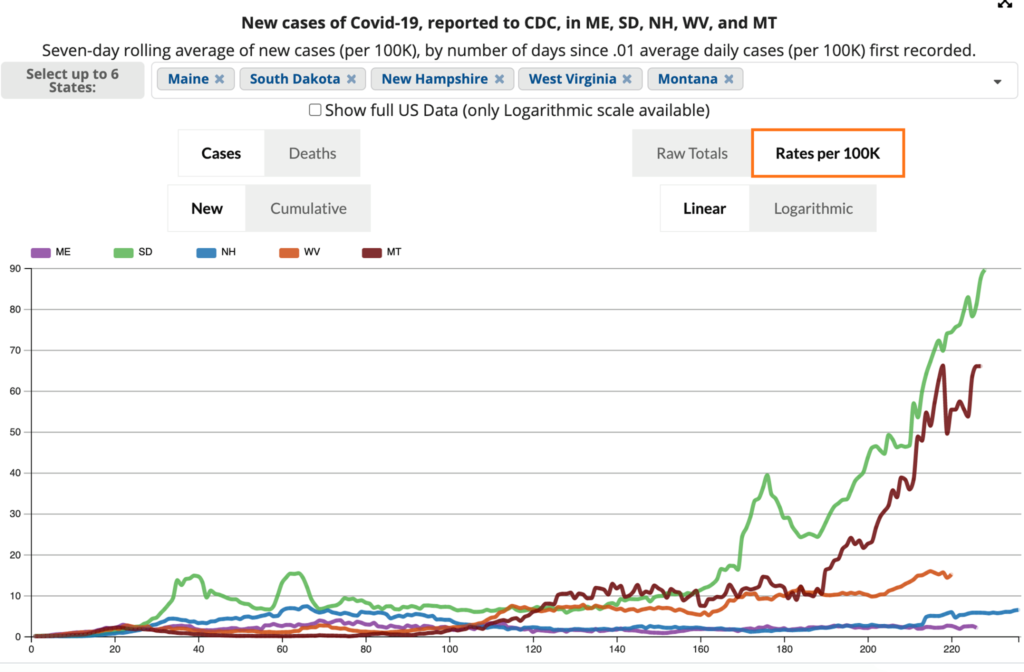A: Nope to those three, but yes to leadership, preparation, testing & tracing, and calm, science-based communication.
It’s true: Maine is doing very well by almost all metrics used to track the epidemic. While 21 states had their highest daily case counts in the last 3 weeks, Maine’s single day record cases happened way back in mid-March (see link below to a graphic of this).
Yes, Maine is very rural, but other rural states have fared much worse. For example, there are seven counties in South Dakota where 7-day case counts per 100,000 population are over 1,000 right now. That means that more than 1% of the residents of those counties tested positive for COVID *this week*. Yikes!
And Maine is not a rich state. In fact, it’s one of the poorest, and it has the oldest population in the country — two risk factors that should predict higher cases and deaths.
Using the CDC’s COVID Data Tracker (link below), we plotted new cases of COVID-19 per 100,000 population for Maine and four comparator states (South Dakota, New Hampshire, West Virginia, and Montana). The plot is shown below, and Maine is the purple line at the bottom. Like, all the way at the bottom. The graph for COVID-19 deaths looks very similar. (See link below to make your own state comparison graphs – fun for the whole family!)
So…how did this happen? What are Mainers getting right? One thing that seems to be making a big difference is their public health leadership. In a recent interview published in Scientific American (link below), Ellen Ruppel Shell talked with Maine CDC Director Dr. Nirav Shah about how he has navigated this crisis. The whole interview is worth a read, but a few things really stood out to us in Dr. Shah’s responses:
#1: Dr. Shah worked in Cambodia during the SARS and avian flu outbreaks. When he heard rumors about a new respiratory virus in late December 2019, he knew he had to act. “As soon as we all returned from the New Year’s break on January 2 or 3, my office started to prepare. By February 8, we had distributed PPE to nursing homes, hospitals and first responders. We had our contact tracing plan all mapped out. This was weeks ahead of our first documented case of COVID-19 on March 12.” That level of preparation gave the state a running start to get ahead of the outbreak come March.
#2: Dr. Shah was able to get good testing capacity in place with in-state labs in May. Easy access to testing across the state means cases are detected early and handed off to Maine’s 100-plus member contact tracing team.
#3: Regular communication is key. Dr. Shah gives daily radio briefings and interviews, and focuses on helping Mainers take action. He notes: “In a high-anxiety, low-trust situation like this, you have to empower people to act. Every five or six weeks, I take stock of where we are and come up with a couple of key asks of the people in Maine. For example, this week, I asked them to commit to get a flu shot. It’s a concrete call to action, something everyone can do for themselves and their family. And it builds confidence and trust.”
Maine’s success story is an excellent reminder of the importance of electing leaders who will appoint and support public health officials like Dr. Shah. Public health is on the ballot this year as it is in every election. Vote for public health!
Scientific American story on Maine CDC Director Dr. Nirav Shah
Make your own state comparison charts
See COVID Tracking Project for “Week of Single-Day Record Cases by State” and other terrific graphics.

Image credit: Alison Buttenheim using CDC’s Covid Data Tracker.


